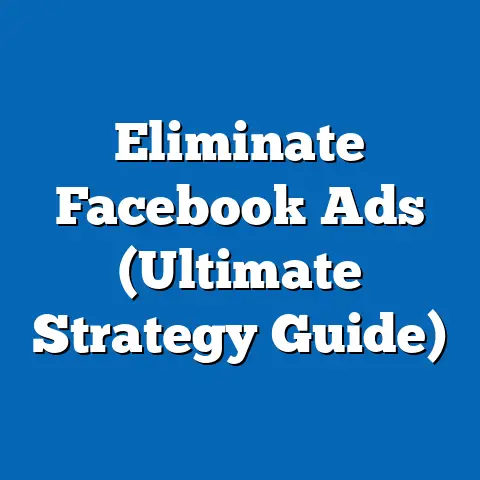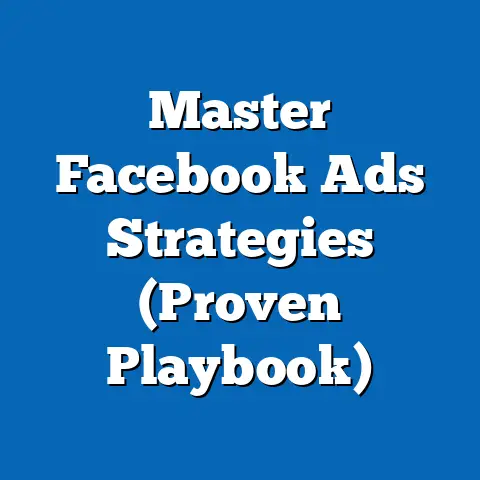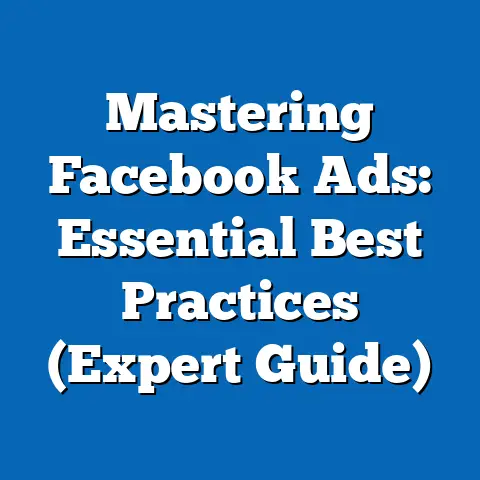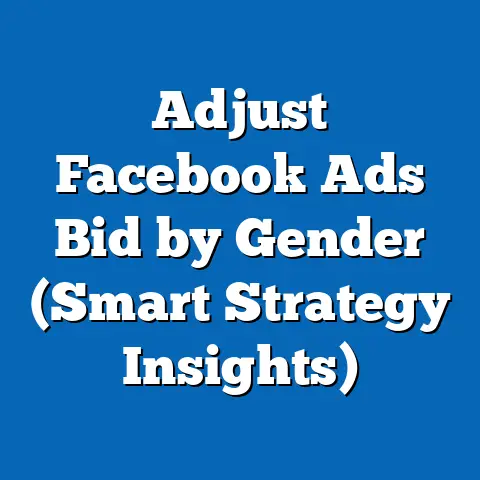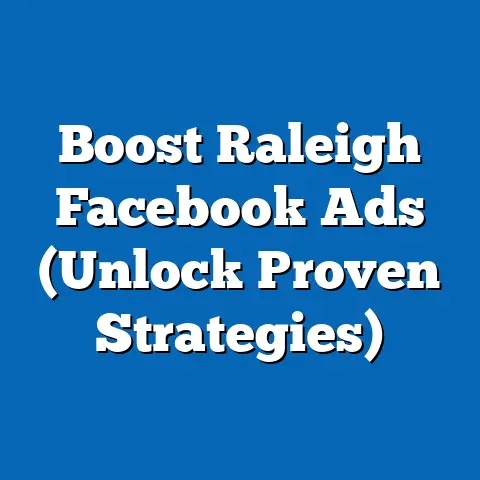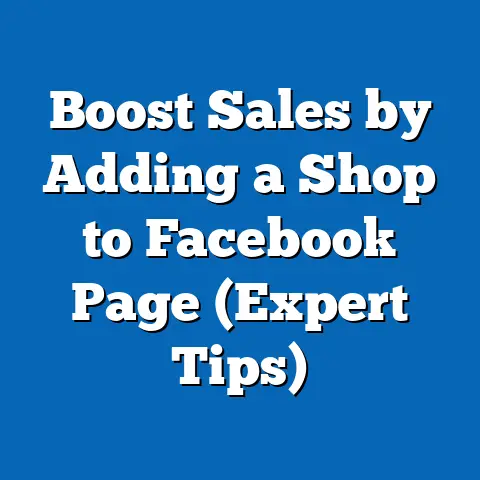Transform Autism Outreach with Facebook Ads (Game-Changer)
How can we leverage the power of social media to create a world where every individual with autism receives the support and resources they need to thrive? This is the question that fuels my passion for digital marketing, and it’s a question I believe we can answer, at least in part, through the strategic use of Facebook Ads.
I’ve seen firsthand how Facebook Ads, when used thoughtfully and with intention, can connect organizations with the very people they’re trying to reach – families, educators, healthcare providers, and individuals on the spectrum themselves. It’s not just about running ads; it’s about crafting a message that resonates, targeting the right audience, and ultimately making a tangible difference in the lives of those affected by autism.
Understanding Autism Outreach
Autism outreach is the collective effort to raise awareness, provide resources, and foster community support for individuals with autism spectrum disorder (ASD) and their families. It’s a critical component of creating a more inclusive and understanding society, ensuring that those affected by autism have access to the services and opportunities they need to thrive.
Think of it as a bridge, connecting those who need help with those who can provide it. This can take many forms, including:
- Awareness Campaigns: Educating the public about autism, dispelling myths, and promoting acceptance.
- Resource Navigation: Connecting families with diagnostic services, therapies, educational programs, and support groups.
- Community Building: Creating opportunities for individuals with autism and their families to connect with one another, share experiences, and build a sense of belonging.
- Advocacy: Working to influence policies and practices that promote the rights and well-being of individuals with autism.
The Importance of Autism Outreach
Effective autism outreach is vital for several reasons:
- Early Intervention: Early diagnosis and intervention are crucial for improving outcomes for individuals with autism. Outreach efforts can help families recognize the signs of autism and access early intervention services.
- Reducing Stigma: By raising awareness and promoting understanding, outreach campaigns can help reduce the stigma associated with autism and create a more accepting society.
- Empowering Families: Providing families with information, resources, and support can empower them to advocate for their children and navigate the challenges of raising a child with autism.
- Building Inclusive Communities: Outreach efforts can help create more inclusive communities where individuals with autism are valued, respected, and have the opportunity to participate fully in all aspects of life.
Current Challenges in Autism Outreach
Despite the importance of autism outreach, organizations and advocates face numerous challenges in effectively reaching their target audience. Some of the most common challenges include:
- Limited Resources: Many autism organizations operate on limited budgets, making it difficult to invest in comprehensive outreach campaigns.
- Reaching Diverse Audiences: Autism affects individuals from all backgrounds, and outreach efforts need to be tailored to reach diverse cultural, linguistic, and socioeconomic groups.
- Cutting Through the Noise: In today’s digital age, it can be difficult to cut through the noise and capture the attention of your target audience.
- Measuring Impact: It can be challenging to measure the impact of outreach efforts and demonstrate their effectiveness to funders and stakeholders.
I remember working with a small, local autism support group that was struggling to reach families in their community. They relied primarily on word-of-mouth and flyers posted in local businesses, but their reach was limited. They knew there were more families out there who needed their support, but they didn’t have the resources or expertise to reach them effectively. This is where innovative solutions, like Facebook Ads, can make a real difference.
The Need for Innovative Solutions
To overcome these challenges, organizations need to embrace innovative solutions that can help them reach their target audience more effectively and efficiently. This includes leveraging the power of digital marketing, particularly social media advertising, to expand their reach, engage their audience, and drive meaningful impact.
Takeaway: Autism outreach is essential for creating a more inclusive and supportive society for individuals with autism and their families. Overcoming the challenges of limited resources, reaching diverse audiences, and measuring impact requires innovative solutions, such as leveraging the power of Facebook Ads.
The Power of Facebook Ads
Facebook Ads have revolutionized the way organizations and businesses connect with their target audiences. With its vast reach, sophisticated targeting options, and cost-effective advertising solutions, Facebook has become an indispensable tool for anyone looking to amplify their message and drive meaningful results.
The Basics of Facebook Advertising
Facebook advertising allows you to create and display ads to users on Facebook, Instagram, and the Audience Network (a network of websites and apps that partner with Facebook to display ads). You can target your ads based on a variety of factors, including demographics, interests, behaviors, and location.
Here are some key components of Facebook advertising:
- Campaign Objective: The goal you want to achieve with your ad campaign (e.g., brand awareness, website traffic, lead generation, conversions).
- Target Audience: The specific group of people you want to reach with your ads.
- Ad Placement: Where you want your ads to appear (e.g., Facebook News Feed, Instagram Stories, Audience Network).
- Ad Budget: The amount of money you’re willing to spend on your ad campaign.
- Ad Creative: The visual and text elements of your ad (e.g., images, videos, headlines, descriptions).
Facebook’s User Demographics
Facebook boasts a massive user base, with over 2.9 billion monthly active users worldwide. This vast reach makes it an ideal platform for connecting with a wide range of audiences, including those affected by autism.
Here are some key demographic statistics about Facebook users:
- Age: Facebook is popular among a wide range of age groups, with a significant presence among adults aged 25-54.
- Gender: The gender distribution on Facebook is relatively balanced, with slightly more female users than male users.
- Location: Facebook has a global presence, with users in virtually every country around the world.
- Interests: Facebook users share a wealth of information about their interests, hobbies, and passions, making it possible to target ads based on specific interests related to autism (e.g., autism awareness, special education, developmental disabilities).
The sheer scale of Facebook’s user base, combined with its detailed demographic data, makes it a powerful platform for autism outreach.
Advantages of Facebook Ads Over Traditional Outreach
Facebook Ads offer several advantages over traditional outreach methods, such as flyers, print ads, and community events:
- Cost-Effectiveness: Facebook Ads can be significantly more cost-effective than traditional advertising methods, allowing you to reach a larger audience with a smaller budget.
- Measurable Results: Facebook provides detailed analytics and reporting tools that allow you to track the performance of your ad campaigns and measure your return on investment (ROI).
- Targeted Reach: Facebook’s sophisticated targeting options allow you to reach specific demographics, interests, and behaviors, ensuring that your ads are seen by the people who are most likely to be interested in your message.
- Scalability: Facebook Ads can be easily scaled up or down to meet your changing needs and budget.
- Real-Time Optimization: You can monitor the performance of your ads in real-time and make adjustments to improve their effectiveness.
I recall running a Facebook Ads campaign for an autism therapy center that had previously relied on print advertising in local newspapers. They were spending a significant amount of money on these ads, but they had no way of knowing how many people were actually seeing them or taking action as a result. By switching to Facebook Ads, they were able to reach a much larger audience at a fraction of the cost, and they could track their results in real-time. This allowed them to optimize their campaigns and generate a much higher ROI.
Takeaway: Facebook Ads offer a powerful and cost-effective way to reach a large and targeted audience for autism outreach. The advantages of measurable results, targeted reach, and scalability make it a superior alternative to traditional outreach methods.
Crafting Effective Facebook Ads for Autism Outreach
Creating effective Facebook Ads for autism outreach requires a thoughtful and strategic approach. It’s not enough to simply throw up an ad and hope for the best. You need to craft a message that resonates with your target audience, design visually appealing creatives, and optimize your campaigns for maximum impact.
Identifying Key Messages
The first step in creating effective Facebook Ads is to identify the key messages you want to convey to your target audience. These messages should be relevant to their needs and interests, and they should clearly communicate the value of your organization or service.
Here are some examples of key messages that might resonate with different segments of the autism community:
- Parents of children with autism: “Find the support and resources you need to help your child thrive.”
- Educators: “Learn strategies for creating inclusive classrooms for students with autism.”
- Individuals with autism: “Connect with a supportive community and discover your strengths.”
- Healthcare providers: “Stay up-to-date on the latest research and best practices in autism care.”
When crafting your messages, be sure to use clear, concise language that is easy to understand. Avoid jargon or technical terms that may confuse your audience.
The Importance of Visuals
Visuals play a critical role in capturing attention and conveying your message effectively on Facebook. Use high-quality images and videos that are visually appealing and relevant to your target audience.
Here are some tips for choosing effective visuals:
- Use real people: Images and videos featuring real people with autism and their families can be highly effective in building trust and connection.
- Show positive emotions: Focus on images and videos that depict positive emotions, such as joy, hope, and connection.
- Keep it simple: Avoid cluttered or distracting visuals. Focus on a single, clear message.
- Use video: Video is a highly engaging format that can be used to tell stories, share information, and showcase your organization’s work.
I’ve found that videos featuring individuals with autism sharing their personal experiences can be particularly powerful. These videos can help to break down stereotypes, promote understanding, and inspire hope.
Storytelling and Emotional Appeal
Storytelling is a powerful tool for connecting with your audience on an emotional level. Share stories of individuals with autism who have overcome challenges, achieved success, or made a positive impact on their community.
Here are some tips for using storytelling in your Facebook Ads:
- Focus on the human element: Tell stories that highlight the human experiences of individuals with autism and their families.
- Be authentic: Share real, genuine stories that are relatable and inspiring.
- Show, don’t tell: Use vivid language and imagery to bring your stories to life.
- End with a call to action: Encourage your audience to take action, such as donating to your organization, volunteering their time, or sharing your story with others.
Testimonials and Success Stories
Testimonials and success stories can be highly effective in building trust and credibility with your audience. Share testimonials from parents, educators, or individuals with autism who have benefited from your organization’s services.
Here are some tips for using testimonials in your Facebook Ads:
- Choose compelling testimonials: Select testimonials that are specific, detailed, and emotionally resonant.
- Use real names and photos: Include the real names and photos of the people providing the testimonials to increase their credibility.
- Highlight key benefits: Focus on testimonials that highlight the specific benefits of your organization’s services.
- Keep it concise: Keep your testimonials short and to the point.
Takeaway: Crafting effective Facebook Ads for autism outreach requires careful attention to messaging, visuals, storytelling, and testimonials. By creating compelling and relevant ads, you can capture the attention of your target audience and drive meaningful results.
Targeting the Right Audience
One of the greatest strengths of Facebook Ads is its ability to target specific audiences based on a wide range of factors. By carefully defining your target audience, you can ensure that your ads are seen by the people who are most likely to be interested in your message and take action.
Facebook’s Targeting Options
Facebook offers a variety of targeting options, including:
- Demographics: Target users based on age, gender, location, education, and other demographic factors.
- Interests: Target users based on their interests, hobbies, and passions.
- Behaviors: Target users based on their online behaviors, such as their purchase history, website visits, and app usage.
- Custom Audiences: Create custom audiences based on your existing customer data, such as email lists or website visitors.
- Lookalike Audiences: Create lookalike audiences based on your existing custom audiences. This allows you to reach new people who are similar to your best customers.
Identifying Your Target Audience
The first step in targeting the right audience is to identify the specific groups of people you want to reach with your ads. This may include:
- Parents of children with autism: Target parents based on their age, location, interests, and behaviors. You can also target parents who have liked pages related to autism or special education.
- Educators: Target teachers, special education teachers, and school administrators based on their job titles, interests, and behaviors.
- Healthcare providers: Target doctors, therapists, and other healthcare providers who specialize in autism care.
- Community organizations: Target autism support groups, advocacy organizations, and other community organizations that serve individuals with autism.
- Individuals with autism: Target individuals based on their age, location, interests, and behaviors. You can also target individuals who have liked pages related to autism or disability rights.
Successful Audience Segmentation Strategies
To maximize the effectiveness of your Facebook Ads, it’s important to segment your audience into smaller, more targeted groups. This allows you to tailor your messages and creatives to the specific needs and interests of each segment.
Here are some examples of successful audience segmentation strategies:
- Parents of young children: Target parents of children aged 2-5 with ads that promote early intervention services.
- Parents of teenagers: Target parents of teenagers with ads that promote vocational training and independent living skills.
- Educators in low-income communities: Target educators in low-income communities with ads that promote free or low-cost resources for students with autism.
- Individuals with autism seeking employment: Target individuals with autism who are seeking employment with ads that promote job training programs and inclusive employers.
I’ve seen great success using Lookalike Audiences to expand the reach of Facebook Ads campaigns. By creating a Lookalike Audience based on a custom audience of existing donors, for example, you can reach new people who are likely to be interested in supporting your organization’s mission.
Takeaway: Targeting the right audience is essential for maximizing the effectiveness of your Facebook Ads. By carefully defining your target audience and segmenting them into smaller, more targeted groups, you can ensure that your ads are seen by the people who are most likely to be interested in your message and take action.
Case Studies of Successful Autism Outreach Campaigns
Analyzing real-life examples of organizations that have successfully used Facebook Ads to enhance their outreach efforts can provide valuable insights and inspiration for your own campaigns. Let’s take a look at a few case studies:
Case Study 1: Autism Speaks
Autism Speaks is a leading autism advocacy organization that uses Facebook Ads extensively to raise awareness, promote research, and provide resources to families.
- Objectives: Increase awareness of autism, drive traffic to their website, and generate donations.
- Strategies: Autism Speaks uses a variety of ad formats, including images, videos, and carousel ads. They target parents, educators, and healthcare providers with messages that are relevant to their specific needs and interests. They also use Lookalike Audiences to expand their reach and generate new leads.
- Ad Designs: Autism Speaks’ ads feature high-quality images and videos that showcase the diversity and resilience of individuals with autism. Their ads also include clear calls to action, such as “Learn More,” “Donate Now,” and “Find Resources.”
- Outcomes: Autism Speaks has seen significant success with their Facebook Ads campaigns, generating millions of impressions, website visits, and donations. They have also been able to increase awareness of autism and promote understanding among a wider audience.
Case Study 2: The Autism Society
The Autism Society is another leading autism advocacy organization that uses Facebook Ads to connect with families, promote events, and advocate for policies that support individuals with autism.
- Objectives: Increase membership, promote local events, and advocate for autism-friendly policies.
- Strategies: The Autism Society uses Facebook Ads to target specific geographic areas, promoting local events and resources to families in those areas. They also use ads to advocate for policies that support individuals with autism, such as increased funding for special education and access to healthcare.
- Ad Designs: The Autism Society’s ads feature images of families participating in local events, as well as messages that highlight the benefits of membership and the importance of advocacy.
- Outcomes: The Autism Society has been able to increase membership, promote local events, and advocate for policies that support individuals with autism through their Facebook Ads campaigns.
Lessons Learned and Best Practices
These case studies highlight several key lessons learned and best practices for using Facebook Ads for autism outreach:
- Define clear objectives: Before launching your campaign, clearly define your objectives and how you will measure success.
- Target the right audience: Carefully define your target audience and segment them into smaller, more targeted groups.
- Craft compelling ads: Create ads that are visually appealing, relevant to your target audience, and include clear calls to action.
- Track your results: Monitor the performance of your ads in real-time and make adjustments to improve their effectiveness.
- Test and optimize: Continuously test different ad creatives, targeting options, and bidding strategies to optimize your campaigns for maximum impact.
I’ve learned that A/B testing is crucial for optimizing Facebook Ads campaigns. By testing different ad creatives and targeting options, you can identify what works best for your audience and improve your results over time.
Takeaway: Analyzing successful autism outreach campaigns on Facebook Ads can provide valuable insights and inspiration for your own efforts. By learning from the successes and failures of others, you can develop more effective strategies and maximize your impact.
Measuring Success and Optimizing Campaigns
Measuring the success of your Facebook Ads campaigns is essential for determining whether your efforts are paying off and for identifying areas for improvement. By tracking key performance indicators (KPIs) and analyzing your data, you can optimize your campaigns for better results.
Key Performance Indicators (KPIs)
Here are some key performance indicators (KPIs) that you should monitor to evaluate the effectiveness of your Facebook Ads campaigns:
- Reach: The number of unique people who saw your ads.
- Impressions: The number of times your ads were displayed.
- Engagement: The number of likes, comments, shares, and clicks your ads received.
- Website Traffic: The number of people who clicked on your ads and visited your website.
- Conversion Rate: The percentage of people who took a desired action, such as donating to your organization, signing up for your email list, or registering for an event.
- Cost Per Click (CPC): The average cost you paid for each click on your ads.
- Cost Per Conversion (CPC): The average cost you paid for each conversion.
- Return on Ad Spend (ROAS): The amount of revenue you generated for every dollar you spent on advertising.
Facebook’s Tools and Metrics
Facebook provides a variety of tools and metrics for tracking the performance of your ad campaigns. These tools include:
- Facebook Ads Manager: A comprehensive platform for creating, managing, and tracking your Facebook Ads campaigns.
- Facebook Pixel: A piece of code that you can install on your website to track conversions and build custom audiences.
- Facebook Analytics: A powerful tool for analyzing user behavior on your website and app.
By using these tools, you can gain valuable insights into the performance of your campaigns and identify areas for improvement.
Analyzing Data and Optimizing Campaigns
Analyzing your data and optimizing your campaigns is an ongoing process. Here are some tips for optimizing your Facebook Ads campaigns for better results:
- Monitor your KPIs: Regularly monitor your KPIs to track the performance of your campaigns.
- Identify trends: Look for trends in your data that can help you identify what’s working and what’s not.
- Test different ad creatives: Test different ad creatives to see which ones resonate best with your audience.
- Adjust your targeting: Adjust your targeting options to reach a more specific audience.
- Optimize your bidding strategy: Experiment with different bidding strategies to see which one generates the best results for your budget.
- Use A/B testing: Use A/B testing to compare different versions of your ads and identify which ones perform best.
I’ve found that optimizing your bidding strategy can have a significant impact on the performance of your Facebook Ads campaigns. By experimenting with different bidding strategies, such as cost-per-click (CPC) bidding and cost-per-impression (CPM) bidding, you can find the strategy that generates the best results for your budget.
Takeaway: Measuring success and optimizing campaigns is essential for maximizing the effectiveness of your Facebook Ads. By tracking key performance indicators (KPIs) and analyzing your data, you can identify areas for improvement and optimize your campaigns for better results.
Overcoming Common Challenges
Implementing Facebook Ads for autism outreach can be challenging, and organizations may face various obstacles along the way. By anticipating these challenges and developing strategies to overcome them, you can increase your chances of success.
Budget Constraints
One of the most common challenges organizations face is budget constraints. Many autism organizations operate on limited budgets, making it difficult to invest in comprehensive Facebook Ads campaigns.
Here are some strategies for overcoming budget constraints:
- Start small: Begin with a small budget and gradually increase it as you see results.
- Focus on targeted advertising: Target your ads to a specific audience to maximize your reach and impact.
- Use cost-effective ad formats: Choose ad formats that are cost-effective, such as image ads or carousel ads.
- Apply for grants: Seek out grants and funding opportunities that can help support your Facebook Ads campaigns.
- Partner with other organizations: Partner with other autism organizations or businesses to share the cost of advertising.
Ad Fatigue
Ad fatigue occurs when your audience becomes tired of seeing the same ads over and over again. This can lead to a decrease in engagement and a decline in your campaign performance.
Here are some strategies for overcoming ad fatigue:
- Rotate your ad creatives: Regularly rotate your ad creatives to keep your audience engaged.
- Target different audiences: Target different audiences to reach new people who haven’t seen your ads before.
- Use different ad formats: Experiment with different ad formats to keep your ads fresh and engaging.
- Refresh your messaging: Regularly refresh your messaging to keep your ads relevant and interesting.
- Pause and restart your campaigns: Pause your campaigns for a few days or weeks and then restart them with fresh creatives and messaging.
Audience Saturation
Audience saturation occurs when you’ve reached a significant portion of your target audience and there are fewer new people to reach. This can lead to a decrease in reach and a decline in your campaign performance.
Here are some strategies for overcoming audience saturation:
- Expand your targeting: Expand your targeting options to reach a wider audience.
- Use Lookalike Audiences: Create Lookalike Audiences to reach new people who are similar to your existing customers or supporters.
- Partner with other organizations: Partner with other autism organizations or businesses to reach new audiences.
- Run contests and giveaways: Run contests and giveaways to attract new followers and increase your reach.
- Promote your ads on other platforms: Promote your ads on other social media platforms or websites to reach a wider audience.
I’ve found that partnering with other organizations can be a highly effective way to overcome audience saturation. By partnering with organizations that serve a similar audience, you can reach new people who are likely to be interested in your message.
Takeaway: Implementing Facebook Ads for autism outreach can be challenging, but by anticipating these challenges and developing strategies to overcome them, you can increase your chances of success. Budget constraints, ad fatigue, and audience saturation are common obstacles, but they can be overcome with careful planning and execution.
Future Trends in Social Media and Autism Outreach
The landscape of social media is constantly evolving, and it’s important to stay up-to-date on the latest trends and technologies to maximize the effectiveness of your autism outreach efforts.
The Rise of Video Content
Video content is becoming increasingly popular on social media, and it’s a highly effective way to engage your audience and convey your message.
Here are some tips for using video content in your Facebook Ads campaigns:
- Create short, engaging videos: Keep your videos short and to the point, focusing on a single, clear message.
- Use compelling visuals: Use high-quality visuals that are visually appealing and relevant to your target audience.
- Tell stories: Use video to tell stories that highlight the human experiences of individuals with autism and their families.
- Add captions: Add captions to your videos to make them accessible to people who are deaf or hard of hearing.
- Optimize for mobile: Optimize your videos for mobile devices, as most people watch videos on their smartphones or tablets.
The Power of Influencer Partnerships
Influencer partnerships can be a highly effective way to reach a wider audience and build trust with your target audience.
Here are some tips for using influencer partnerships in your Facebook Ads campaigns:
- Identify relevant influencers: Identify influencers who have a strong following and are respected within the autism community.
- Collaborate on content: Collaborate with influencers to create content that is authentic, engaging, and relevant to your target audience.
- Promote the content: Promote the content on Facebook Ads to reach a wider audience.
- Track your results: Track the results of your influencer partnerships to see how they are impacting your campaign performance.
Community Building Strategies
Building a strong online community can be a powerful way to connect with your audience, foster engagement, and promote your organization’s mission.
Here are some tips for building a strong online community:
- Create a Facebook Group: Create a Facebook Group where people can connect with one another, share experiences, and ask questions.
- Host live Q&A sessions: Host live Q&A sessions with experts in autism care to provide valuable information and answer questions from your audience.
- Run contests and giveaways: Run contests and giveaways to attract new followers and increase engagement.
- Share valuable content: Share valuable content that is relevant to your audience’s needs and interests.
- Respond to comments and messages: Respond to comments and messages promptly to show your audience that you care.
The Impact of AI and Machine Learning
Advancements in technology, such as AI and machine learning, are poised to further enhance autism outreach efforts. These technologies can be used to:
- Personalize ad experiences: AI can be used to personalize ad experiences based on individual user preferences and behaviors.
- Automate campaign optimization: Machine learning can be used to automate campaign optimization, making it easier to improve your results over time.
- Identify new audiences: AI can be used to identify new audiences that are likely to be interested in your message.
- Detect and prevent ad fraud: Machine learning can be used to detect and prevent ad fraud, ensuring that your budget is being spent effectively.
I believe that AI and machine learning will play an increasingly important role in Facebook Ads in the years to come. By embracing these technologies, organizations can create more effective and efficient campaigns that reach a wider audience and drive meaningful impact.
Takeaway: The future of social media and autism outreach is bright. By staying up-to-date on the latest trends and technologies, such as video content, influencer partnerships, community building strategies, and AI/machine learning, you can maximize the effectiveness of your Facebook Ads campaigns and make a greater impact on the autism community.
Conclusion
So, how can we leverage the power of social media to create a world where every individual with autism receives the support and resources they need to thrive? As I’ve outlined in this guide, Facebook Ads offer a powerful and transformative tool for autism outreach. By understanding the basics of Facebook advertising, crafting effective ads, targeting the right audience, measuring success, and overcoming common challenges, you can revolutionize your outreach efforts and make a tangible difference in the lives of those affected by autism.
I encourage you to take action, whether by adopting Facebook Ads in your own initiatives or by advocating for innovative outreach strategies within your communities. The potential for positive change is immense, and together, we can create a more inclusive and supportive world for individuals with autism.
The journey doesn’t end here. Continue to explore, experiment, and refine your strategies. Share your successes and learn from your challenges. Let’s work together to unlock the full potential of Facebook Ads and transform autism outreach for the better.

